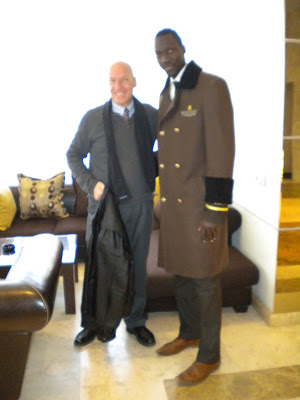

Yesterday I bought a large book of historical photographs (mostly nineteenth century) of Kyiv. Included are several shots of the monastery of St. Michael of the Golden Domes, which is less than 100 paces from my apartment. Reading about these historical photographs as well as reading my new book about the Cathedral of St. Volodymyr, which I wrote about yesterday, the long tragic and ultimately triumphant story of St. Michaels has become clear in my mind.
Pictured above is the front of the main Cathedral from the base of the belltower. Pictured below is the rear of the Cathedral with the smaller refectory chapel of St. John the Theologian on the left. The entire monastery is enclosed within high walls. There is also a magnificent bell tower fronting on the public square. This gives the reader some sense of the layout of the complex.
The monastery was founded in about 1050 A.D. and the original church, on the site of the present Cathedral, was built after 1100. This original church was reportedly the first church in Kyiv to have gilded domes--hence the name "St. Michael of the Golden Domes." The monastery became a magnet for generations of pilgrims, chiefly because the relics of St. Barbara were housed here. In my new book I have a nineteenth century picture of thousands of pilgrims climbing the steep hillsides in long lines beneath the statue of St. Volodymyr and on up to St. Michaels. St. Barbara's relics were brought to Kyiv from Constantinople in 1108 by the wife of Sviatapolk Iziaslavych's wife in a silver reliquary. As I wrote yesterday, during the Soviet era, these relics were removed to St. Volodymyr's Cathedral, where they remain to this day.
(Incidentally, I had an interesting experience yesterday during the hour or so I stood alone in St. Volodymyr's near St. Barbara's relics. They are now preserved in a sarcophagus-like container housed beneath a magnificent golden canopy with marble steps. I saw several people walk up the steps to view the relics, so I thought--why not. I went up the steps for a brief view. As I quietly walked back down the steps I was accosted by a most officious gentleman who asked me (in Russian) if I was a Christian. "Yes," I said. "Then why don't you make the sign of the cross? You must always make the sign of the cross as you approach or walk away from sacred things!" He was not pleased with me. I, of course, did not want to be disrespectful, but did not heed his demands that I make the sign of the cross--I could only think of Daniel and his companions who refused to pray as directed by Nebuchanezzar when they heard the sound of "the cornet, flute, harp, sackbut, dulcimer and all kinds of music.")
The Golden Domes were pulled down and the Cathedral destroyed by the Soviet's in about 1936, and a new administrative complex for the Ukrainian S.S.R. was built on the ruins. Apparently there were tennis and volleyball courts on the actual site of the Cathedral. The monastic buildings just north of the Cathedral were apparently party offices--my friend Wilfried Voge told me that his wife remembers attending social events there as a child. After the collapse of the Soviet Union the Cathedral was rebuilt on the ancient site.
The little chapel dedicated to St. John the Theologian, which was built in 1713, is the original structure and survived the Soviet desecration of the monastery. It was used as a locker room for the Soviet sports complex on the site during the dark years of Soviet rule.
There is, of course, a lesson in all of this--that nothing is irrevocably lost. The new Cathedral is now the centerpiece of a thriving, vibrant and joyful monastery, which has apparently become the training seminary for many of the nations Ukrainian Orthodox priests. Although not an ancient structure, the new Cathedral is most beautiful inside.

















































